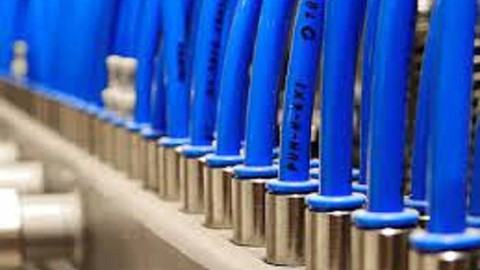
Introduction of Hydraulics and Pneumatics
Introduction of Hydraulics and Pneumatics, available at Free, has an average rating of 3.8, with 6 lectures, based on 85 reviews, and has 2140 subscribers.
You will learn about Engineering and undergraduate This course is ideal for individuals who are Engineering students It is particularly useful for Engineering students.
Enroll now: Introduction of Hydraulics and Pneumatics
Summary
Title: Introduction of Hydraulics and Pneumatics
Price: Free
Average Rating: 3.8
Number of Lectures: 6
Number of Published Lectures: 6
Number of Curriculum Items: 6
Number of Published Curriculum Objects: 6
Original Price: Free
Quality Status: approved
Status: Live
What You Will Learn
- Engineering and undergraduate
Who Should Attend
- Engineering students
Target Audiences
- Engineering students
In the industry we use three methods for transmitting power from one point to another. Mechanical transmission is through shafts, gears, chains, belts, etc. Electrical transmission is through wires, transformers, etc. Fluid power is through liquids or gas in a confined space. In this chapter, we shall discuss a structure of hydraulic systems and pneumatic systems. We will also discuss the advantages and disadvantages and compare hydraulic, pneumatic, electrical and mechanical systems.
Industrial fluid power systems is the technology that deals with the generation, control and transmission of forces and movement of mechanical element or system with the use of pressurized fluids in a confined system. Both liquids and gases are considered fluids. Fluid power system includes a hydraulic system (hydra meaning water in Greek) and a pneumatic system (pneuma meaning air in Greek). Oil hydraulic employs pressurized liquid petroleum oils and synthetic oils, and pneumatic employs compressed air that is released to the atmosphere after performing the work.
Perhaps it would be in order that we clarify our thinking on one point. By the term “fluid” we refer to air or oil, for it has been shown that water has certain drawbacks in the transmission of hydraulic power in machine operation and control. Commercially, pure water contains various chemicals (some deliberately included) and also foreign matter, and unless special precautions are taken when it is used, it is nearly impossible to maintain valves and working surfaces in satisfactory condition. In the cases where the hydraulic system is closed (i.e., the one with a self-contained unit that serves one machine or one small group of machines), oil is commonly used, thus providing, in addition to power transmission, benefits of lubrication not afforded by water as well as increased life and efficiency of packings and valves. It should be mentioned that in some special cases, soluble oil diluted with water is used for safety reasons. The application of fluid power is limited only by the ingenuity of the designer, production engineer or plant engineer. If the application pertains to lifting, pushing, pulling, clamping, tilting, forcing, pressing or any other straight line (and many rotary) motions, it is possible that fluid power will meet the requirement.
Mobile hydraulic systems move on wheels or tracks such as a tower crane or excavator truck to operate in many different locations or while moving. A characteristic feature of mobile hydraulics is that the valves are frequently manually operated.
Hydraulics and pneumatics have almost unlimited application in the production of goods and services in nearly all sectors of the country. Several industries are dependent on the capabilities that fluid power affords.
Course Curriculum
Chapter 1: Introduction
Lecture 1: Introduction of Hydraulics and Pneumatics
Lecture 2: Hydraulic Actuator
Lecture 3: Fluid Power Control Valves
Lecture 4: Hydraulic Circuit
Lecture 5: Pneumatics System and it's components
Lecture 6: Hydraulic System Design
Instructors
-
Pardeshi Mohansing Rameshsing
M-Tech Machine Design Assistant Professor
Rating Distribution
- 1 stars: 4 votes
- 2 stars: 4 votes
- 3 stars: 23 votes
- 4 stars: 18 votes
- 5 stars: 36 votes
Frequently Asked Questions
How long do I have access to the course materials?
You can view and review the lecture materials indefinitely, like an on-demand channel.
Can I take my courses with me wherever I go?
Definitely! If you have an internet connection, courses on Udemy are available on any device at any time. If you don’t have an internet connection, some instructors also let their students download course lectures. That’s up to the instructor though, so make sure you get on their good side!
You may also like
- Best Video Editing Courses to Learn in March 2025
- Best Music Production Courses to Learn in March 2025
- Best Animation Courses to Learn in March 2025
- Best Digital Illustration Courses to Learn in March 2025
- Best Renewable Energy Courses to Learn in March 2025
- Best Sustainable Living Courses to Learn in March 2025
- Best Ethical AI Courses to Learn in March 2025
- Best Cybersecurity Fundamentals Courses to Learn in March 2025
- Best Smart Home Technology Courses to Learn in March 2025
- Best Holistic Health Courses to Learn in March 2025
- Best Nutrition And Diet Planning Courses to Learn in March 2025
- Best Yoga Instruction Courses to Learn in March 2025
- Best Stress Management Courses to Learn in March 2025
- Best Mindfulness Meditation Courses to Learn in March 2025
- Best Life Coaching Courses to Learn in March 2025
- Best Career Development Courses to Learn in March 2025
- Best Relationship Building Courses to Learn in March 2025
- Best Parenting Skills Courses to Learn in March 2025
- Best Home Improvement Courses to Learn in March 2025
- Best Gardening Courses to Learn in March 2025






















